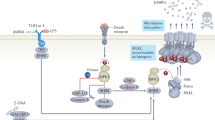Abstract
Nephropathic cystinosis is characterized clinically by generalized proximal renal tubular dysfunction, renal Fanconi Syndrome and progressive renal failure. Glomerular–proximal tubule disconnection has been noted in renal biopsies from patients with nephropathic cystinosis. In vitro studies performed in cystinotic fibroblasts and renal proximal tubular cells support a role for apoptosis of the glomerulotubular junction, and we have further extended these studies to human native cystinotic kidney specimens. We performed semi-quantitative analysis of tubular density in kidney biopsies from patients with nephropathic cystinosis and demonstrated a significant reduction (p = 0.0003) in the number of proximal tubules in the kidney tissue of patients with cystinosis compared to normal kidneys and kidneys with other causes of renal injury; this reduction appears to be associated with the over-expression of caspase-4. This study provides the first quantitative evidence of a loss of proximal tubules in nephropathic cystinosis and suggests a possible role of caspase-4 in the apoptotic loss of proximal tubular cells. Further work is needed to elucidate if this injury mechanism may be causative for the progression of renal functional decline in nephropathic cystinosis.


Similar content being viewed by others
References
Gahl WA, Thoene JG, Schneider JA (2002) Cystinosis. N Engl J Med 347:111–121
Schneider JA, Clark KF, Greene AA, Reisch JS, Markello TC, Gahl WA, Thoene JG, Noonan PK, Berry KA (1995) Recent advances in the treatment of cystinosis. J Inherit Metab Dis 18:387–397
Fetterman GH, Fabrizio NS (1966) The application of renal microdissection to the study of kidney disease in infancy and childhood. Clin Pediatr (Phila) 5:626–634
Mahoney CP, Striker GE (2000) Early development of the renal lesions in infantile cystinosis. Pediatr Nephrol 15:50–56
Park M, Helip-Wooley A, Thoene J (2002) Lysosomal cystine storage augments apoptosis in cultured human fibroblasts and renal tubular epithelial cells. J Am Soc Nephrol 13:2878–2887
Park MA, Pejovic V, Kerisit KG, Junius S, Thoene JG (2006) Increased apoptosis in cystinotic fibroblasts and renal proximal tubule epithelial cells results from cysteinylation of protein kinase Cdelta. J Am Soc Nephrol 17:3167–3175
Wilmer MJ, van den Heuvel LP, Rodenburg RJ, Vogel RO, Nijtmans LG, Monnens LA, Levtchenko EN (2008) Mitochondrial complex V expression and activity in cystinotic fibroblasts. Pediatr Res 64:495–497
Kleta R, Gahl WA (2004) Pharmacological treatment of nephropathic cystinosis with cysteamine. Expert Opin Pharmacother 5:2255–2262
Gretz N, Manz F, Augustin R, Barrat TM, Bender-Gotze C, Brandis M, Bremer HJ, Brodehl J, Broyer M, Bulla M, Callis L, Chantler C, Diekmann L, Dillon MJ, Egli F, Ehrich JH, Endres W, Fanconi A, Feldhoff C, Geisert J, Gekle D, Gescholl-Bauer B, Grote K, Gruttner R, Hagge W, Haycock CB, Hennemann H, Klare B, Leupold D, Lohr H, Michalk D, Oliveira A, Ott F, Pistor K, Rau J, Scharer K, Schindera F, Schmidt H, Schulte-Wissermann H, Verrier-Jones K, Weber HP, Willenbockel U, Wolf H (1983) Survival time in cystinosis. A collaborative study. Proc Eur Dial Transplant Assoc 19:582–589
Coor C, Salmon RF, Quigley R, Marver D, Baum M (1991) Role of adenosine triphosphate (ATP) and NaK ATPase in the inhibition of proximal tubule transport with intracellular cystine loading. J Clin Invest 87:955–961
Foreman JW, Benson LL, Wellons M, Avner ED, Sweeney W, Nissim I, Nissim I (1995) Metabolic studies of rat renal tubule cells loaded with cystine: the cystine dimethylester model of cystinosis. J Am Soc Nephrol 6:269–272
Kamens J, Paskind M, Hugunin M, Talanian RV, Allen H, Banach D, Bump N, Hackett M, Johnston CG, Li P, Mankovich JA, Terranova M, Ghayur T (1995) Identification and characterization of ICH-2, a novel member of the interleukin-1 beta-converting enzyme family of cysteine proteases. J Biol Chem 270:15250–15256
Lin XY, Choi MS, Porter AG (2000) Expression analysis of the human caspase-1 subfamily reveals specific regulation of the CASP5 gene by lipopolysaccharide and interferon-gamma. J Biol Chem 275:39920–39926
Yukioka F, Matsuzaki S, Kawamoto K, Koyama Y, Hitomi J, Katayama T, Tohyama M (2008) Presenilin-1 mutation activates the signaling pathway of caspase-4 in endoplasmic reticulum stress-induced apoptosis. Neurochem Int 52:683–687
Morishima N, Nakanishi K, Takenouchi H, Shibata T, Yasuhiko Y (2002) An endoplasmic reticulum stress-specific caspase cascade in apoptosis. Cytochrome c-independent activation of caspase-9 by caspase-12. J Biol Chem 277:34287–34294
Hitomi J, Katayama T, Eguchi Y, Kudo T, Taniguchi M, Koyama Y, Manabe T, Yamagishi S, Bando Y, Imaizumi K, Tsujimoto Y, Tohyama M (2004) Involvement of caspase-4 in endoplasmic reticulum stress-induced apoptosis and Abeta-induced cell death. J Cell Biol 165:347–356
Wei H, Kim SJ, Zhang Z, Tsai PC, Wisniewski KE, Mukherjee AB (2008) ER and oxidative stresses are common mediators of apoptosis in both neurodegenerative and non-neurodegenerative lysosomal storage disorders and are alleviated by chemical chaperones. Hum Mol Genet 17:469–477
Acknowledgements
This work was supported by the grants from Cystinosis Foundation Ireland and Health Research Board Ireland.
Competing interest statement
The authors declare that they have no competing financial interest.
Author information
Authors and Affiliations
Corresponding author
Rights and permissions
About this article
Cite this article
Sansanwal, P., Kambham, N. & Sarwal, M.M. Caspase-4 may play a role in loss of proximal tubules and renal injury in nephropathic cystinosis. Pediatr Nephrol 25, 105–109 (2010). https://doi.org/10.1007/s00467-009-1289-4
Received:
Revised:
Accepted:
Published:
Issue Date:
DOI: https://doi.org/10.1007/s00467-009-1289-4




